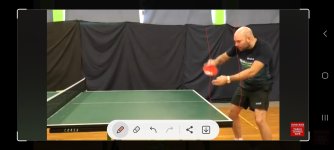This user has no status.
This user has no status.
Well-Known Member
I think both is right, just watching the ball can be dangerous on fast and spinny serves, but just watching the racket movement can also mislead you if you face guys like Brett Clarke who know how to serve very deceiptive.
His snakeserve is lookin' like a reverse pendulum but has the spin of a pendulum serve. So just watching the racket movement can give you serious problems as well.
But learning to serve deceiptive for yourself can really do the trick.
Just remember:
your serve is the only stroke you make that isn't being influenced by your opponent.
The safest way to receive is to always wait for the fast serve to attack it, 2 bounce serves and half long serves are always slow. Now if you have adapted well to the server's habbits sometimes you can predict if the serve is fast, again by peripheral vision a fraction of a second before the ball is hit.
So if the serve is long you are ready, if it is half long you either push early or wait for it to come to you and topspin/push/flick. And id the serve is short you step in and play
A good demonstration of what Im describing is pierre luce hinse's video
And one of my favorite tutorials on ready position by Massimo Constantini ( ICC coach if I remember correctly)
Check them also, gold information on receiving/ready position/stance












